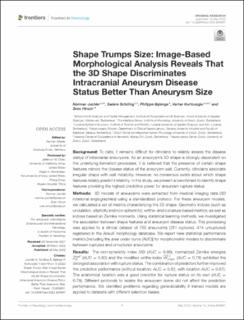Please use this identifier to cite or link to this item:
https://doi.org/10.21256/zhaw-24987| Publication type: | Article in scientific journal |
| Type of review: | Peer review (publication) |
| Title: | Shape trumps size : image-based morphological analysis reveals that the 3D shape discriminates intracranial aneurysm disease status better than aneurysm size |
| Authors: | Juchler, Norman Schilling, Sabine Bijlenga, Philippe Kurtcuoglu, Vartan Hirsch, Sven |
| et. al: | No |
| DOI: | 10.3389/fneur.2022.809391 10.21256/zhaw-24987 |
| Published in: | Frontiers in Neurology |
| Volume(Issue): | 13 |
| Issue: | 809391 |
| Issue Date: | 3-May-2022 |
| Publisher / Ed. Institution: | Frontiers Research Foundation |
| ISSN: | 1664-2295 |
| Language: | English |
| Subjects: | Intracranial aneurysm; Quantitative morphology; Image-based analysis; Rupture status prediction; Shape irregularity |
| Subject (DDC): | 616: Internal medicine and diseases |
| Abstract: | Background: To date, it remains difficult for clinicians to reliably assess the disease status of intracranial aneurysms. As an aneurysm's 3D shape is strongly dependent on the underlying formation processes, it is believed that the presence of certain shape features mirrors the disease status of the aneurysm wall. Currently, clinicians associate irregular shape with wall instability. However, no consensus exists about which shape features reliably predict instability. In this study, we present a benchmark to identify shape features providing the highest predictive power for aneurysm rupture status. Methods: 3D models of aneurysms were extracted from medical imaging data (3D rotational angiographies) using a standardized protocol. For these aneurysm models, we calculated a set of metrics characterizing the 3D shape: Geometry indices (such as undulation, ellipticity and non-sphericity); writhe- and curvature-based metrics; as well as indices based on Zernike moments. Using statistical learning methods, we investigated the association between shape features and aneurysm disease status. This processing was applied to a clinical dataset of 750 aneurysms (261 ruptured, 474 unruptured) registered in the AneuX morphology database. We report here statistical performance metrics [including the area under curve (AUC)] for morphometric models to discriminate between ruptured and unruptured aneurysms. Results: The non-sphericity index NSI (AUC = 0.80), normalized Zernike energies ZsurfN (AUC = 0.80) and the modified writhe-index WL1mean (AUC = 0.78) exhibited the strongest association with rupture status. The combination of predictors further improved the predictive performance (without location: AUC = 0.82, with location AUC = 0.87). The anatomical location was a good predictor for rupture status on its own (AUC = 0.78). Different protocols to isolate the aneurysm dome did not affect the prediction performance. We identified problems regarding generalizability if trained models are applied to datasets with different selection biases. Conclusions: Morphology provided a clear indication of the aneurysm disease status, with parameters measuring shape (especially irregularity) being better predictors than size. Quantitative measurement of shape, alone or in conjunction with information about aneurysm location, has the potential to improve the clinical assessment of intracranial aneurysms. |
| URI: | https://digitalcollection.zhaw.ch/handle/11475/24987 |
| Fulltext version: | Published version |
| License (according to publishing contract): | CC BY 4.0: Attribution 4.0 International |
| Departement: | Life Sciences and Facility Management |
| Organisational Unit: | Institute of Computational Life Sciences (ICLS) |
| Published as part of the ZHAW project: | AneuX |
| Appears in collections: | Publikationen Life Sciences und Facility Management |
Files in This Item:
| File | Description | Size | Format | |
|---|---|---|---|---|
| 2022_Juchler-etal_Shape-trumps-size-aneurysm_frontiers.pdf | 1.7 MB | Adobe PDF |  View/Open |
Show full item record
Juchler, N., Schilling, S., Bijlenga, P., Kurtcuoglu, V., & Hirsch, S. (2022). Shape trumps size : image-based morphological analysis reveals that the 3D shape discriminates intracranial aneurysm disease status better than aneurysm size. Frontiers in Neurology, 13(809391). https://doi.org/10.3389/fneur.2022.809391
Juchler, N. et al. (2022) ‘Shape trumps size : image-based morphological analysis reveals that the 3D shape discriminates intracranial aneurysm disease status better than aneurysm size’, Frontiers in Neurology, 13(809391). Available at: https://doi.org/10.3389/fneur.2022.809391.
N. Juchler, S. Schilling, P. Bijlenga, V. Kurtcuoglu, and S. Hirsch, “Shape trumps size : image-based morphological analysis reveals that the 3D shape discriminates intracranial aneurysm disease status better than aneurysm size,” Frontiers in Neurology, vol. 13, no. 809391, May 2022, doi: 10.3389/fneur.2022.809391.
JUCHLER, Norman, Sabine SCHILLING, Philippe BIJLENGA, Vartan KURTCUOGLU und Sven HIRSCH, 2022. Shape trumps size : image-based morphological analysis reveals that the 3D shape discriminates intracranial aneurysm disease status better than aneurysm size. Frontiers in Neurology. 3 Mai 2022. Bd. 13, Nr. 809391. DOI 10.3389/fneur.2022.809391
Juchler, Norman, Sabine Schilling, Philippe Bijlenga, Vartan Kurtcuoglu, and Sven Hirsch. 2022. “Shape Trumps Size : Image-Based Morphological Analysis Reveals That the 3D Shape Discriminates Intracranial Aneurysm Disease Status Better than Aneurysm Size.” Frontiers in Neurology 13 (809391). https://doi.org/10.3389/fneur.2022.809391.
Juchler, Norman, et al. “Shape Trumps Size : Image-Based Morphological Analysis Reveals That the 3D Shape Discriminates Intracranial Aneurysm Disease Status Better than Aneurysm Size.” Frontiers in Neurology, vol. 13, no. 809391, May 2022, https://doi.org/10.3389/fneur.2022.809391.
Items in DSpace are protected by copyright, with all rights reserved, unless otherwise indicated.